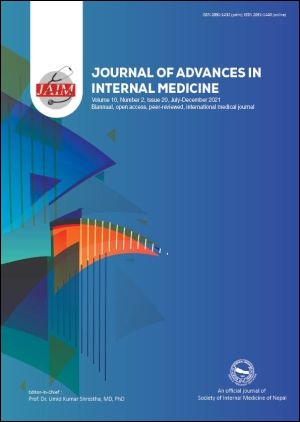Magnetic Resonance Imaging Brain and Electroencephalogram (EEG) in the Evaluation of New-Onset Seizures in a Tertiary Care Centre of Nepal
DOI:
https://doi.org/10.3126/jaim.v10i2.42171Keywords:
epilepsy, electroencephalography, magnetic resonance imaging, seizureAbstract
Introduction: Seizure is a common neurological condition with multiple etiological factors. This study aims to evaluate the role of magnetic resonance imaging (MRI) Brain and electroencephalography (EEG) in the diagnosis of new-onset seizures in the Nepalese population.
Methods: A total of 106 patients aged between 7 to 85 years of age with first onset seizure, who underwent MRI and EEG were enrolled in the study. The sensitivity of MRI and EEG for the diagnosis of seizure when used in combination was compared with that of MRI or EEG alone.
Results: Out of 106 patients, 58.5% (n=62) were males and 41.5% (n=44) were females. In 52.8% (n= 56) of the patients, there was epileptogenic lesion in MRI, and 39.6% (n=42) of the patients had an abnormal EEG. The combination of MRI with EEG was significantly better than either MRI or EEG alone in the diagnosis of seizures (p <0.001).
Conclusion: MRI and EEG are frequently used for the evaluation of seizures. MRI Brain when used in combination with EEG significantly improves the diagnostic accuracy of seizures.
Downloads
Downloads
Published
How to Cite
Issue
Section
License
Copyright (c) 2021 BR Pokharel, P Upadhaya, GR Sharma, SJ Budathoki, AMS Maharjan, G Kharel, S Phuyal

This work is licensed under a Creative Commons Attribution 4.0 International License.
This license enables reusers to distribute, remix, adapt, and build upon the material in any medium or format, so long as attribution is given to the creator.




